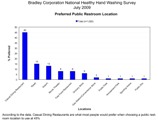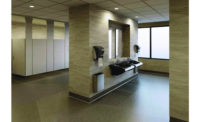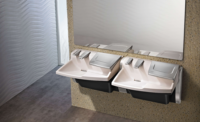Worries about the spread of the H1N1 virus haven’t changed the majority of Americans’ hand washing habits, according to a national survey conducted by Bradley Corp., a manufacturer of commercial plumbing fixtures and washroom accessories.
In Bradley’s first Healthy Hand Washing Survey, 54% of the 1,020 respondents said they “wash their hands no more or less frequently” in public restrooms as a result of the H1N1 virus. “Influenza A viruses, of which swine flu is one, are fragile viruses that can be easily destroyed through proper hygiene, including use of soap and water and alcohol-based hand sanitizers,” says Dr. Judy Daly, spokesperson for the American Society for Microbiology, director of the clinical microbiology laboratories, primary children’s medical center, Salt Lake City. “Flu viruses most frequently enter the body when contaminated hands touch mucous membranes of the nose, eyes, and mouth. Frequent hand hygiene certainly makes this transfer less likely.”
“We found the response to the H1N1 question extremely surprising, especially since the medical community has said over and over that hand washing is the best defense against the spread of cold and flu viruses,” says Jon Dommisse, director of marketing and product development at Bradley Corp.
“It’s more important than ever for building owners and facility managers to continue to maintain and improve their restrooms to help encourage people to use these facilities,” he says. Bradley’s Healthy Hand Washing Survey was conducted online July 28-31, 2009, and queried 1,020 American adults about their hand washing habits in public restrooms. Participants were from around the country, evenly divided among men and women, and ranged in age from 18 to 65 and older.

Figure 1.
Self-Reported Habits vs. Observational Research
Overall, 87% of respondents said they did wash their hands after using public lavatories, but other responses indicated that some may have exaggerated how often they actually did the job correctly. When asked if they had also used soap, the numbers declined only slightly, to 86 percent; yet 55% of the group admitted on occasion they’ve simply rinsed, without using soap.In contrast to what people say they do, numerous observational studies question what Americans actually do. In 2007, researchers for the American Society of Microbiology found that only 77%t actually wash their hands after using a public restroom. In 2003 and 2004, the Minnesota Department of Health, Division of Environmental Health observed hand-washing practices at the Minnesota state fairgrounds. During the 2004 Minnesota State Fair, 75% of women and just 51% of men washed their hands with soap and water after using the public restroom.
Soap and Water Best Preventative Medicine
The U.S. Centers for Disease Control and Prevention (CDC) is unequivocal about the benefits of hand washing, calling it critical in preventing infection and illness: “Hand washing is a simple thing to do and it’s the best way to prevent infection and illness,” the agency says. And by “washing your hands,” the CDC notes that nothing beats good old soap and water.Asked why they did not wash their hands before leaving a public restroom, respondents identified a number of reasons, such as the sinks weren’t working, the wash area appeared unclean, the sink area was crowded and they didn’t feel the need to wash. However, 28% of those who didn’t wash their hands said they used a hand sanitizer instead. The primary reason respondents cited for not using soap, rinsing only with water, was that the soap dispensers were empty.
Children’s Hand Washing Habits
The survey also asked parents about their children’s hand washing habits. The respondents indicated they believe their children wash their hands with soap and water 68% of the time after using the school restroom.
Hand washing among school-age children is especially important because it’s estimated that at least 22 million school days are lost every year due to the common cold, according to the CDC. Illness can spread from student to student throughout the school so it’s important that students wash their hands after using the bathroom, before eating and after coughing, sneezing or blowing their nose.
“Hand washing is a lifetime health practice that children should know about, understand the benefits of and take with them into adulthood,” says Dommisse.

Figure 2.
Restroom Likes and Dislikes
When it came to the type of public restrooms they preferred [Figure 1], nearly half the survey respondents (45%) chose casual dining restaurants, followed by retail stores (15%) and airports (13%). Restrooms in movie theaters, fast-food restaurants and grocery stores scored below 10%, with parks, sports arenas and zoos all earning just 1 percent approval.The least favorite public restroom type [Figure 2]? Gas stations and convenience stores. The reasons some restroom categories ranked high or low were not surprising: Respondents preferred restrooms that were clean, well-maintained and uncrowded, and were turned off by those they found to be dirty, poorly maintained, not well stocked or unattended.
Parents helping their children were especially frustrated by empty or jammed towel dispensers, having no space to put belongings, water collecting on sink counters, and sinks and soap dispensers that were too high for children to reach.
For more information, visitwww.bradleycorp.com.


